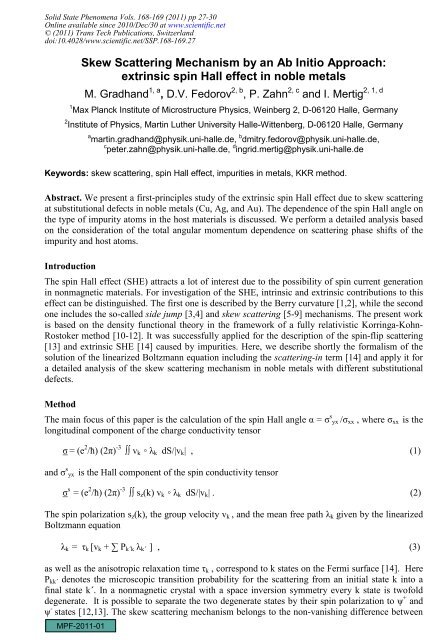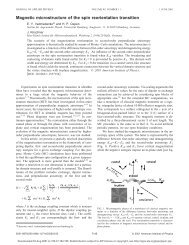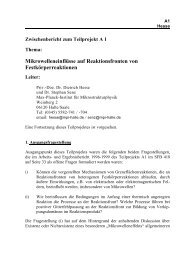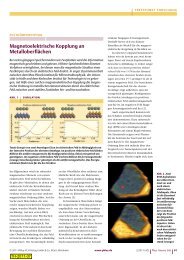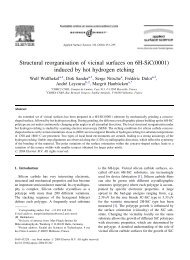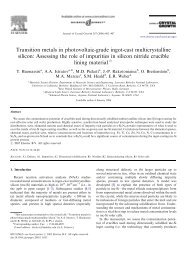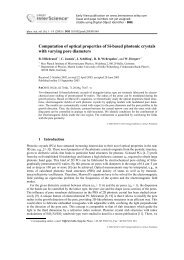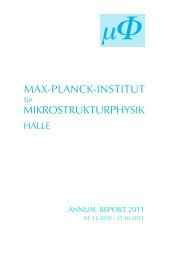Skew Scattering Mechanism by an Ab Initio Approach: extrinsic spin ...
Skew Scattering Mechanism by an Ab Initio Approach: extrinsic spin ...
Skew Scattering Mechanism by an Ab Initio Approach: extrinsic spin ...
Create successful ePaper yourself
Turn your PDF publications into a flip-book with our unique Google optimized e-Paper software.
Solid State Phenomena Vols. 168-169 (2011) pp 27-30<br />
Online available since 2010/Dec/30 at www.scientific.net<br />
© (2011) Tr<strong>an</strong>s Tech Publications, Switzerl<strong>an</strong>d<br />
doi:10.4028/www.scientific.net/SSP.168-169.27<br />
<strong>Skew</strong> <strong>Scattering</strong> <strong>Mech<strong>an</strong>ism</strong> <strong>by</strong> <strong>an</strong> <strong>Ab</strong> <strong>Initio</strong> <strong>Approach</strong>:<br />
<strong>extrinsic</strong> <strong>spin</strong> Hall effect in noble metals<br />
M. Gradh<strong>an</strong>d 1, a , D.V. Fedorov 2, b , P. Zahn 2, c 2, 1, d<br />
<strong>an</strong>d I. Mertig<br />
1 Max Pl<strong>an</strong>ck Institute of Microstructure Physics, Weinberg 2, D-06120 Halle, Germ<strong>an</strong>y<br />
2 Institute of Physics, Martin Luther University Halle-Wittenberg, D-06120 Halle, Germ<strong>an</strong>y<br />
a martin.gradh<strong>an</strong>d@physik.uni-halle.de, b dmitry.fedorov@physik.uni-halle.de,<br />
c peter.zahn@physik.uni-halle.de, d ingrid.mertig@physik.uni-halle.de<br />
Keywords: skew scattering, <strong>spin</strong> Hall effect, impurities in metals, KKR method.<br />
<strong>Ab</strong>stract. We present a first-principles study of the <strong>extrinsic</strong> <strong>spin</strong> Hall effect due to skew scattering<br />
at substitutional defects in noble metals (Cu, Ag, <strong>an</strong>d Au). The dependence of the <strong>spin</strong> Hall <strong>an</strong>gle on<br />
the type of impurity atoms in the host materials is discussed. We perform a detailed <strong>an</strong>alysis based<br />
on the consideration of the total <strong>an</strong>gular momentum dependence on scattering phase shifts of the<br />
impurity <strong>an</strong>d host atoms.<br />
Introduction<br />
The <strong>spin</strong> Hall effect (SHE) attracts a lot of interest due to the possibility of <strong>spin</strong> current generation<br />
in nonmagnetic materials. For investigation of the SHE, intrinsic <strong>an</strong>d <strong>extrinsic</strong> contributions to this<br />
effect c<strong>an</strong> be distinguished. The first one is described <strong>by</strong> the Berry curvature [1,2], while the second<br />
one includes the so-called side jump [3,4] <strong>an</strong>d skew scattering [5-9] mech<strong>an</strong>isms. The present work<br />
is based on the density functional theory in the framework of a fully relativistic Korringa-Kohn-<br />
Rostoker method [10-12]. It was successfully applied for the description of the <strong>spin</strong>-flip scattering<br />
[13] <strong>an</strong>d <strong>extrinsic</strong> SHE [14] caused <strong>by</strong> impurities. Here, we describe shortly the formalism of the<br />
solution of the linearized Boltzm<strong>an</strong>n equation including the scattering-in term [14] <strong>an</strong>d apply it for<br />
a detailed <strong>an</strong>alysis of the skew scattering mech<strong>an</strong>ism in noble metals with different substitutional<br />
defects.<br />
Method<br />
The main focus of this paper is the calculation of the <strong>spin</strong> Hall <strong>an</strong>gle α = σ s yx /σxx , where σxx is the<br />
longitudinal component of the charge conductivity tensor<br />
σ = (e 2 /ћ) (2π) -3 ∫∫ vk ◦ λk dS/|vk| , (1)<br />
<strong>an</strong>d σ s yx is the Hall component of the <strong>spin</strong> conductivity tensor<br />
σ s = (e 2 /ћ) (2π) -3 ∫∫ sz(k) vk ◦ λk dS/|vk| . (2)<br />
The <strong>spin</strong> polarization sz(k), the group velocity vk , <strong>an</strong>d the me<strong>an</strong> free path λk given <strong>by</strong> the linearized<br />
Boltzm<strong>an</strong>n equation<br />
λk = τk [vk + ∑ Pk´k λk´ ] , (3)<br />
as well as the <strong>an</strong>isotropic relaxation time τk , correspond to k states on the Fermi surface [14]. Here<br />
Pkk´ denotes the microscopic tr<strong>an</strong>sition probability for the scattering from <strong>an</strong> initial state k into a<br />
final state k´. In a nonmagnetic crystal with a space inversion symmetry every k state is twofold<br />
degenerate. It is possible to separate the two degenerate states <strong>by</strong> their <strong>spin</strong> polarization to ψ + <strong>an</strong>d<br />
ψ - states [12,13]. The skew scattering mech<strong>an</strong>ism belongs to the non-v<strong>an</strong>ishing difference between
28 Trends in Magnetism<br />
the scattering probabilities of the two states, (P ++ kk´ - P -- kk´). Using time <strong>an</strong>d space inversion<br />
symmetry, one c<strong>an</strong> write (P ++ kk´ - P -- kk´) = (P ++ kk´ - P ++ -k´-k) = (P ++ kk´ - P ++ k´k). Thus, as it was<br />
mentioned already in Ref. [15], the <strong>an</strong>ti-symmetric part of the scattering rate Pkk´ is the reason for<br />
the skew scattering. The formalism described above <strong>an</strong>d used in this work is valid for dilute alloys,<br />
assuming the presence of non-interacting impurities in the host materials [14,16]. In the dilute limit<br />
both conductivities, σxx <strong>an</strong>d σ s yx , are inversely proportional to the number of impurities [14], while<br />
the <strong>spin</strong> Hall <strong>an</strong>gle is concentration independent <strong>by</strong> its definition.<br />
Results<br />
As <strong>an</strong> illustration of skew scattering, the difference between the microscopic tr<strong>an</strong>sition probabilities<br />
of ψ + <strong>an</strong>d ψ - states in a Au host with Li <strong>an</strong>d<br />
Zn impurities is presented in Fig. 1. Here the<br />
qu<strong>an</strong>tization axis is chosen to be in the z<br />
direction. The distribution of (P ++ kk´ - P -- kk´) is<br />
shown for the incoming state k propagating<br />
along the x direction <strong>an</strong>d final states k´<br />
available at the Fermi surface. The clear<br />
left/right asymmetry between the two states<br />
with the opposite <strong>spin</strong> polarization is the<br />
origin of the spatial <strong>spin</strong> separation, i.e. of the<br />
Fig.1. The distribution of (P ++ kk´ - P -- kk´) with k in<br />
[100] direction for states k´ on the Fermi surface of<br />
Au (for Li <strong>an</strong>d Zn impurities).<br />
SHE. In addition, as it is demonstrated <strong>by</strong><br />
both Fig. 1 <strong>an</strong>d Table 1, the SHE c<strong>an</strong> have<br />
opposite sign depending on the chemical<br />
nature of impurity atoms. Moreover, the sign<br />
as well as the magnitude of the SHE strongly<br />
depend on the considered host material (see Table 1).<br />
TABLE 1. The <strong>spin</strong> Hall <strong>an</strong>gle α, the <strong>spin</strong> Hall conductivity σ s yx , <strong>an</strong>d the longitudinal charge<br />
conductivity σxx for different impurity atoms in Cu, Ag, <strong>an</strong>d Au hosts. The conductivities are<br />
shown at <strong>an</strong> impurity concentration of 1 at.%.<br />
Cu Ag Au<br />
α<br />
10 -3<br />
σ s yx<br />
(10 3 µΩcm) -1<br />
σxx<br />
(µΩcm) -1<br />
α<br />
10 -3<br />
σ s yx<br />
(10 3 µΩcm) -1<br />
σxx<br />
(µΩcm) -1<br />
α<br />
10 -3<br />
σ s yx<br />
(10 3 µΩcm) -1<br />
σxx<br />
(µΩcm) -1<br />
Li 2.3 2.8 1.22 8.66 11.0 1.27 7.2 4.3 0.60<br />
Be 0.37 0.75 2.04 -1.01 -1.7 1.68 -13.4 -12.5 0.93<br />
B 2.0 0.89 0.45 10.4 2.8 0.27 76.4 16.8 0.22<br />
C 6.6 1.0 0.16 11.7 1.4 0.12 96.0 12.0 0.12<br />
N 7.0 0.75 0.11 11.0 1.1 0.10 64.0 5.3 0.08<br />
Mg -1.5 -2.3 1.57 -4.78 -10.0 2.09 -8.2 -5.5 0.67<br />
Ni 5.0 5.92 1.19 2.45 2.7 1.10 2.46 4.79 1.95<br />
Cu − − − 8.92 420 47.1 -0.44 -1.3 2.96<br />
Ag 0.26 7.9 30.2 − − − 4.8 17.0 3.47<br />
Pt 27.0 13.6 0.51 17.2 11.0 0.64 10.0 9.0 0.93<br />
Au 7.8 18.5 2.37 -14.9 -43.0 2.89 − − −<br />
Bi 81.0 18.1 0.22 95.3 14.3 0.15 14.0 1.9 0.13
Solid State Phenomena Vols. 168-169 29<br />
FIG.2. The differences between the scattering<br />
phase shifts of <strong>an</strong> impurity <strong>an</strong>d the host atom<br />
for the levels j=l±1/2 with l=1 for a) Cu, b)<br />
Ag, <strong>an</strong>d c) Au hosts.<br />
Strong <strong>spin</strong>-orbit coupling at the scattering<br />
centres is a well-known origin for pronounced<br />
skew scattering [5,6]. In our case this condition is<br />
fulfilled for the Cu(Bi) <strong>an</strong>d Ag(Bi) alloys (Table<br />
1). However, other relatively heavy impurities as<br />
Au <strong>an</strong>d Pt do not provide a large <strong>spin</strong> Hall <strong>an</strong>gle<br />
comparable to that for Bi impurities. In addition,<br />
the effect is weak in Au(Bi) as well. Surprisingly,<br />
light impurities like B, C, <strong>an</strong>d N in the Au host<br />
provide large α, though their own <strong>spin</strong>-orbit<br />
interaction is small.<br />
To underst<strong>an</strong>d these results, we exploit the fact<br />
that the Fermi surfaces of the noble metals have a<br />
simple topology [12]. It allows us to use a<br />
spherical b<strong>an</strong>d approximation with <strong>an</strong> <strong>an</strong>alysis of<br />
the scattering phase shifts δj at the Fermi level EF<br />
for the total <strong>an</strong>gular momentum j=l±1/2. We<br />
restrict our consideration to p electrons (l=1) only,<br />
since their scattering dominates over the effect in<br />
the noble metals. In Fig. 2 (a), (b), <strong>an</strong>d (c) the<br />
values of ∆δ1/2(EF) = δ1/2 imp (EF) - δ1/2 host (EF) <strong>an</strong>d<br />
∆δ3/2(EF) = δ3/2 imp (EF) - δ3/2 host (EF) are shown for<br />
the Cu, Ag, <strong>an</strong>d Au hosts, respectively. The<br />
absolute values of such effective phase shifts<br />
indicate the scattering strength of the<br />
corresponding partial waves at the impurity site.<br />
Strong scattering leads to a decrease of the<br />
relaxation time. It is well known that for σxx the<br />
first term on the r.h.s. of Eq. 3 is the dominating<br />
one. On the other h<strong>an</strong>d, it was shown in Ref. [14]<br />
that this term does not contribute to σ s yx , <strong>an</strong>d the<br />
scattering-in term (the second one on the r.h.s of<br />
Eq. 3) is m<strong>an</strong>datory. A general trend for ∆δ1/2(EF)<br />
<strong>an</strong>d ∆δ3/2(EF) as functions of the impurity atom is<br />
almost host independent, since Cu, Ag, <strong>an</strong>d Au are<br />
isovalent elements. The difference |∆δ1/2(EF) -<br />
∆δ3/2(EF)| shows the strength of the left/right<br />
asymmetry of scattering for electrons with<br />
opposite orientations of the <strong>spin</strong> polarization.<br />
Thus, for a strong SHE it is necessary to have at<br />
the same time large absolute values of ∆δ1/2(EF),<br />
∆δ3/2(EF) <strong>an</strong>d ∆δ1/2(EF) - ∆δ3/2(EF).<br />
Let us consider first the heavy impurities.<br />
According to Fig. 2, Bi is the only strong p<br />
scatterer of them. In addition, the effective <strong>spin</strong>-<br />
orbit splitting, |∆δ1/2(EF) - ∆δ3/2(EF)|, depends strongly on the host. For Au this qu<strong>an</strong>tity is reduced<br />
in comparison to the Ag <strong>an</strong>d Cu hosts because of a stronger <strong>spin</strong>-orbit coupling of the host. As a<br />
consequence, σ s yx caused <strong>by</strong> the Bi impurities is largest in copper. The larger value of α in the Ag<br />
host in comparison to Cu is due to the smaller longitudinal conductivity (see Table 1). The situation<br />
with the light p scatterer-impurities (B, C, <strong>an</strong>d N) is opposite. They do not have a strong <strong>spin</strong>-orbit<br />
interaction <strong>by</strong> themselves. That is why the largest effective <strong>spin</strong>-orbit scattering (Fig. 2) <strong>an</strong>d, as a
30 Trends in Magnetism<br />
result, the strongest SHE (Table 1) are present in Au. This mech<strong>an</strong>ism is similar to the strong <strong>spin</strong>flip<br />
scattering at light impurities [13]. As it was discussed already in Ref. [14], the extremely large<br />
α induced <strong>by</strong> the C impurities in the Au host leads to <strong>an</strong> alternative expl<strong>an</strong>ation of the gig<strong>an</strong>tic SHE<br />
measured in gold [17].<br />
Summary<br />
We have performed ab initio calculations of the <strong>extrinsic</strong> <strong>spin</strong> Hall effect caused <strong>by</strong> different<br />
substitutional impurities in the Cu, Ag, <strong>an</strong>d Au hosts. Depending on the chemical nature of the<br />
impurity atom, the SHE c<strong>an</strong> show opposite sign. A strong SHE is provided <strong>by</strong> the p scatterer-<br />
impurity. They have to be either light, such as B, C, <strong>an</strong>d N, in a heavy host like Au, or heavy, such<br />
as Bi, in a light host like Cu. We have shown that the obtained results for the noble metals c<strong>an</strong> be<br />
explained <strong>by</strong> the consideration of the differences of the scattering phase shifts between the impurity<br />
<strong>an</strong>d host atoms.<br />
References<br />
[1] R. Karplus <strong>an</strong>d J.M. Luttinger, Phys. Rev. Vol. 95 (1954), p. 1154.<br />
[2] J. Sinova, D. Culcer, Q. Niu, N.A. Sinitsyn, T. Jungwirth, <strong>an</strong>d A.H. MacDonald, Phys. Rev.<br />
Lett. Vol. 92 (2004), p. 126603.<br />
[3] L. Berger, Phys. Rev. B Vol. 2 (1970), p. 4559.<br />
[4] L. Berger, Phys. Rev. B Vol. 5 (1972), p. 1862.<br />
[5] N.F. Mott <strong>an</strong>d H.S. Massey, The Theory of Atomic Collisions (Clarendon Press, Oxford, 1965).<br />
[6] L.D. L<strong>an</strong>dau <strong>an</strong>d E.M. Lifshitz, Qu<strong>an</strong>tum Mech<strong>an</strong>ics (Pergamon, New York, 1965).<br />
[7] J. Smit, Physica (Amsterdam) Vol. 21 (1955), p. 877.<br />
[8] J. Smit, Physica (Amsterdam) Vol. 24 (1958), p. 39.<br />
[9] M.I. Dyakonov <strong>an</strong>d V.I. Perel, Phys. Lett. A Vol. 35 (1971), p. 459.<br />
[10] S. Takada, Prog. Theor. Phys. Vol. 36 (1966), p. 224.<br />
[11] Y. Onodera <strong>an</strong>d M. Okazaki, J. Phys. Soc. Jpn. Vol. 21 (1966), p. 1273.<br />
[12] M. Gradh<strong>an</strong>d, M. Czerner, D.V. Fedorov, P. Zahn, B.Yu. Yavorsky, L. Szunyogh, <strong>an</strong>d<br />
I. Mertig, Phys. Rev. B Vol. 80 (2009), p. 224413.<br />
[13] M. Gradh<strong>an</strong>d, D.V. Fedorov, P. Zahn, <strong>an</strong>d I. Mertig, Phys. Rev. B Vol. 81 (2010), p.<br />
020403(R).<br />
[14] M. Gradh<strong>an</strong>d, D.V. Fedorov, P. Zahn, <strong>an</strong>d I. Mertig, Phys. Rev. Lett. Vol. 104 (2010), p.<br />
186403.<br />
[15] N.A. Sinitsyn, J. Phys. Condens. Matter Vol. 20 (2008), p. 023201.<br />
[16] I. Mertig, Rep. Prog. Phys. Vol. 62 (1999), p. 237.<br />
[17] T. Seki, Y. Hasegawa, S. Mit<strong>an</strong>i, S. Takahashi, H. Imamura, S. Maekawa, J. Nitta, <strong>an</strong>d K.<br />
Tak<strong>an</strong>ashi, Nature Materials Vol. 7 (2008), p. 125.
Trends in Magnetism<br />
doi:10.4028/www.scientific.net/SSP.168-169<br />
<strong>Skew</strong> <strong>Scattering</strong> <strong>Mech<strong>an</strong>ism</strong> <strong>by</strong> <strong>an</strong> <strong>Ab</strong> <strong>Initio</strong> <strong>Approach</strong>: Extrinsic Spin Hall Effect in<br />
Noble Metals<br />
doi:10.4028/www.scientific.net/SSP.168-169.27


